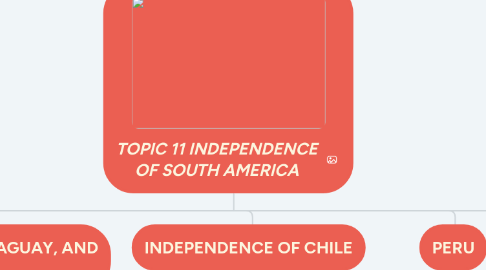TOPIC 11 INDEPENDENCE OF SOUTH AMERICA
저자: cristina espinosa

1. NEW GRANADA AND VENEZUELA
1.1. In 1817,Bolívar, Piar, Páez, and other Venezuelan leaders reactivated the war in 1818. Morillo counterattacked and defeated Bolivar in the valley of Aragua. Then Bolívar defeated in the battle of Pantano de Vargas (25-07-1819). which sealed the independence of New Granada. One more year of skirmishes and Morillo and Bolívar sign the War Regularization Treaty (27-11-1820) The royalist army was defeated in the battle of Carabobo, the final victory of Venezuela's independence (June 25, 1821).
2. INDEPENDENCE OF ECUADOR
2.1. Guayaquil (9-10-1820), the arrival of the patriot army commanded by Antonio José de Sucre, and its triumph in Pichincha (24-05-1822), which culminated the independence of the Great Colombia. Bolivar defeated the royalist pastures in the battle of Bomboná, and entered triumphant Quito (16-06-1822)
3. ARGENTINA, PARAGUAY, AND URUGUAY
3.1. The first Junta de Buenos Aires (25-051810) organized three military campaigns to subdue the Spanish forces in the interior. However, a revolution spontaneously broke out in Asuncion (14-05-1811).This is how the Republic of Paraguay was created. Colonel José Artigas defeated the royalists at the Battle of Las Piedras (18-05-1811) The Oriental Republic of Uruguay, fed up with its disappointments with the centralism of Buenos Aires, and after the War with Brazil (1825-1828), it would be established as an independent entity in 1828. Another federalist initiative was led by General José de San Martín, which founded the United Provinces of South America (9-07-1816).
4. INDEPENDENCE OF CHILE
4.1. San Martin had to liberate Chile. The crossing was epic, but, as they had planned, the six columns met less than a month later in the Aconcagua Valley and although it suffered a serious defeat in CanchaRayada (19-03-1818), it triumphed in the decisive battle of Maipú (5-04-1818), assuring the independence of Chile.
5. PERU
5.1. San Martín managed to buy a naval squadron to attack the Spaniards in Peru by sea. San Martin sailed from Valparaíso (20-08-1820) with a fleet of eight warships and 16 transport ships, and 4,500 men from the armies of the Andes and Chile. It disembarked in Pisco (8-09-1820), and forced the realistic army to retreat towards the mountain range. The uprising in favor of the independence of the Realista Regiment Numancia - integrated by Venezuelans and Quiteños - opened the doors of Lima to San Martin (July 5, 1821), and forced the viceroy La Serna to leave the city and enter the mountains, with an army still very numerous. San Martin declared independence (28-07-1821) and was appointed Protector of Peru with full civil and military authority.
6. SAN MARTIN AND BOLIVAR
6.1. Guayaquil (26 and 27- 07-1822), Bolivar and San Martin talked about what was missing to complete the freedom of America: the defeat of Peru. San Martin gave Bolivar the initiative of the war completely. He returned to Lima, resigned from the government of Peru (20- 091822), and returned to his home in Mendoza, Argentina (01-1823). A year later he emigrated to Europe, where he died in 1850.
7. END OF THE WAR OF INDEPENDENCE
7.1. In 1823, Bolívar was authorized to take command of an expedition to Peru. Bolivar and Sucre defeated the Spanish army at the Battle of Junín (6-08-1824). Four months later, Sucre was forced to give battle and destroyed the last bastion of the Spanish army at the battle of Ayacucho (9-12-1824) , which put an end to Spanish rule in South America.Sucre went to Alto Peru in 1825 and made it independent as a sovereign


